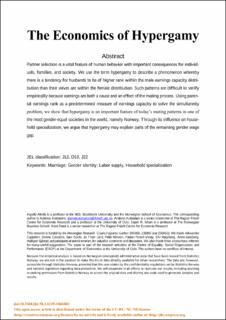| dc.contributor.author | Almås, Ingvild | |
| dc.contributor.author | Kotsadam, Andreas | |
| dc.contributor.author | Moen, Espen Rasmus | |
| dc.contributor.author | Røed, Knut | |
| dc.date.accessioned | 2022-02-14T11:53:18Z | |
| dc.date.available | 2022-02-14T11:53:18Z | |
| dc.date.created | 2020-10-21T12:28:51Z | |
| dc.date.issued | 2020 | |
| dc.identifier.citation | The Journal of human resources. 2020, . | |
| dc.identifier.issn | 0022-166X | |
| dc.identifier.uri | https://hdl.handle.net/11250/2978738 | |
| dc.description.abstract | Partner selection is a vital feature of human behavior with important consequences for individuals, families, and society. We use the term hypergamy to describe a phenomenon whereby there is a tendency for husbands to be of higher rank within the male earnings capacity distribution than their wives are within the female distribution. Such patterns are difficult to verify empirically because earnings are both a cause and an effect of the mating process. Using parental earnings rank as a predetermined measure of earnings capacity to solve the simultaneity problem, we show that hypergamy is an important feature of today’s mating patterns in one of the most gender-equal societies in the world, namely Norway. Through its influence on household specialization, we argue that hypergamy may explain parts of the remaining gender wage gap. | |
| dc.language.iso | eng | |
| dc.title | The Economics of Hypergamy | |
| dc.type | Peer reviewed | |
| dc.type | Journal article | |
| dc.description.version | publishedVersion | |
| dc.source.pagenumber | 37 | |
| dc.source.journal | The Journal of human resources | |
| dc.identifier.doi | 10.3368/jhr.58.3.1219-10604R1 | |
| dc.identifier.cristin | 1841168 | |
| dc.relation.project | Norges forskningsråd: 250415 | |
| cristin.ispublished | true | |
| cristin.fulltext | original | |
| cristin.qualitycode | 2 | |
